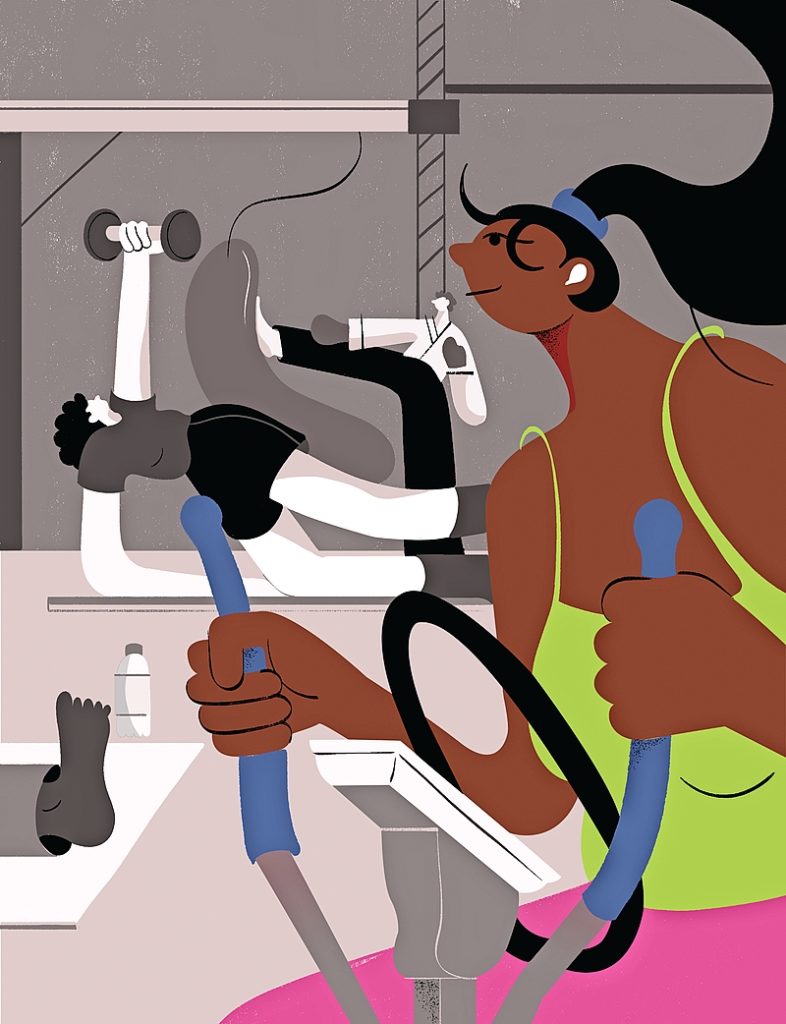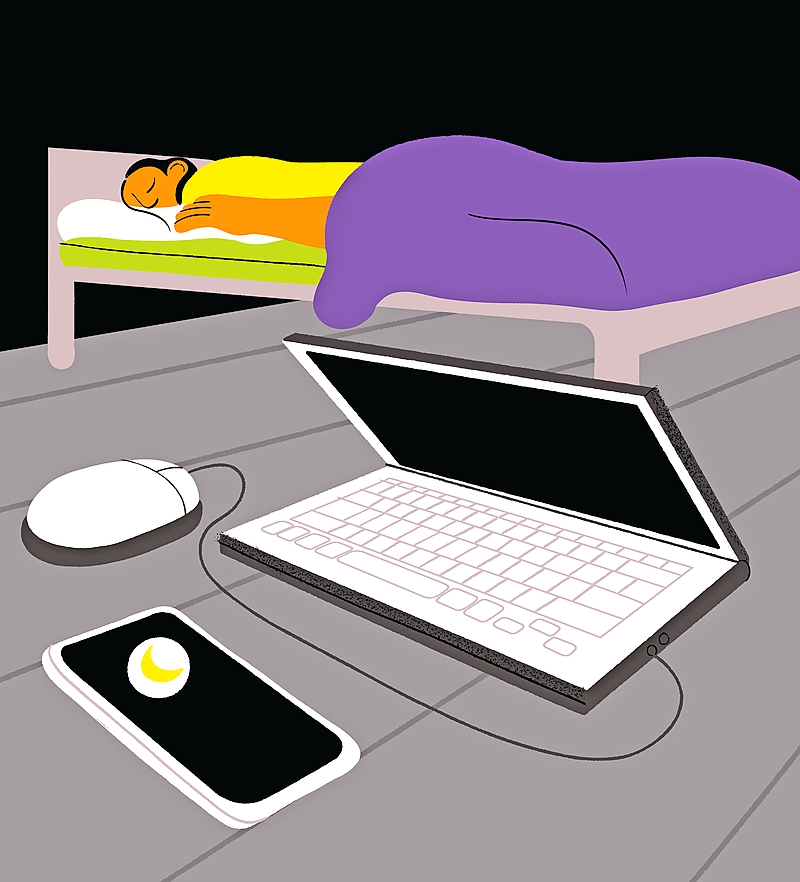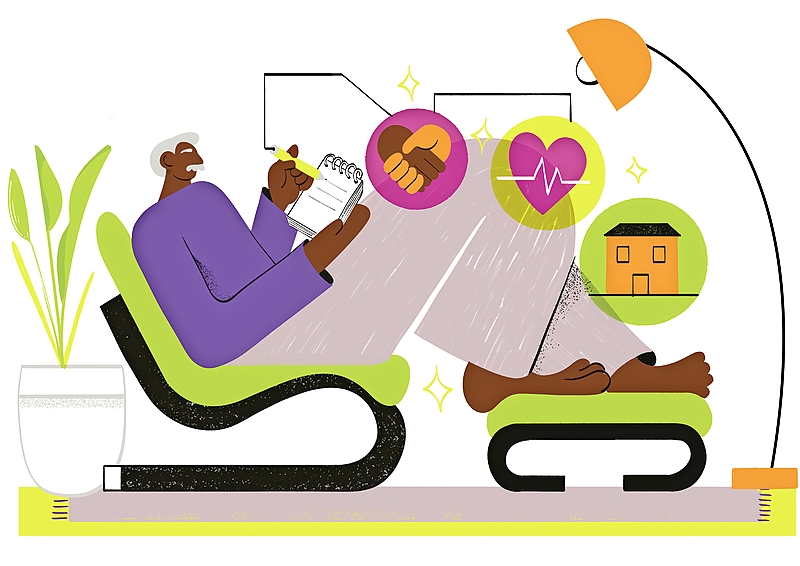Whole-Body Fitness
By Naperville Magazine
January 2023 View more Featured
By Lisa Arnett and Mark Loehrke
20 tips to level up your nutrition, sleep, physical fitness, and mental health

As cliché as New Year’s resolutions can feel, there is something about flipping to a new calendar page that feels like a fresh start. “As everybody looks ahead at the new year, sometimes resolutions or goals fail because we are looking at something unrealistic like dropping 50 pounds quickly or what are we going to give up?” says Toni Havala, an outpatient dietitian with NorthShore–Edward-Elmhurst Health. Physician Kuljeet (Kelly) Gill, a sleep medicine specialist who directs Northwestern Central DuPage Hospital’s sleep lab, agrees. “With our patients, it’s got to be realistic or we’re not going to do it,” she says. “But simple changes add up to a huge change.”
To help you make some moves toward getting your whole body tuned up this year, we consulted local experts in the fields of physical fitness, nutrition, sleep medicine, and mental health. Whether you’re looking to wake up more well rested or avoid that afternoon slump, here are a slew of moves for positive change.
1. Find your fit
People are often too quick to chase the latest fitness trend without really determining whether it’s something they actually like to do. Jen Hoeft, owner and head trainer at J-Fit in Naperville, says the key to sticking with a fitness routine is finding something you’ll look forward to doing, be it cardio, yoga, strength training, walking, virtual classes, hiking, biking, or whatever. “Find something you enjoy,” she says. “You’re more likely to stick with it longer and make it a habit.”
2. Stretch more
One the easiest places to start improving one’s physical fitness is by paying more attention to stretching, says Kyle Heindl, a fitness specialist at Edward-Elmhurst Health in Naperville. Best of all, improving one’s flexibility and mobility through stretching doesn’t require any expensive, state-of-the-art equipment—just a little effort. “Routine stretching improves blood flow to muscles, enhances performance, and reduces soreness and injury,” he says. Heindl recommends stretching after every workout, targeting each muscle group, and holding stretches for at least 30 seconds. “Mild discomfort while stretching is OK, but any pain should be avoided.”
3. Create bookends for your routine
When it comes to finding the motivation to exercise, some days will be more difficult than others. But Heindl says starting your workout session each time with the same warm-up and finishing with a standard cooldown can help make getting into a routine easier. He advises kicking things off with a few light dynamic stretches to loosen up the body along with a brief bout of low-intensity cardio, and then ending with one or two core exercises you enjoy, along with a stretching routine or a cooldown walk. “Prepare for the difficult days by having a beginning and an end that is easily repeatable,” he says. “That is how we set ourselves up for success.”
4. Find a friend
In Hoeft’s experience, turning fitness social by being around other people helps make it more fun and keeps you accountable. “Our squad is more than a workout—it’s a community that comes together to sweat, smile, laugh, and encourage each other,” she says. Better still, grab one of those friends, set a goal, and commit to a race or event that you can work toward together. “Put it down in your calendar so it’s already blocked out and a nonnegotiable.”
5. Look for fitness wherever you can find it
A consistent workout routine is essential, but what about the time spent outside the gym? Heindl stresses the importance of nonexercise activity thermogenesis (NEAT), or the energy expended doing everyday tasks. He recommends looking for ways to increase movement throughout the day by simply standing more often, taking the stairs instead of the elevator, or parking at the far end of the parking lot to get in more steps. “We have been blessed with an incredible machine that should be utilized every chance we get,” he says. “Be mindful of other ways you can keep yourself moving.”
Nutrition
6. Boost your fiber intake
“There are so many functions of fiber—people write whole books on it—but for zero calories, you get tons of benefits, so it’s a very important part of our diet,” Havala says. “Fiber is something we don’t digest, so we don’t absorb it. It helps us feel very full without ever adding one single ounce of body fat to us. It also feeds the good bacteria in our intestines, which are super important for preventing disease and maintaining good health overall. Fiber also adheres to cholesterol and helps escort it out of the body.” Havala recommends keeping chia seeds or flaxseed on hand to toss into breakfast foods. “You don’t have to do one single bit of preparation to add them to oatmeal, yogurt, smoothies, or cottage cheese, and they add a ton of fiber and protein.”
7. Build a better snack
If you’re reaching for a carb-heavy afternoon snack such as crackers, it may not be enough to power you through until dinnertime. “When you have a blood-sugar spike and crash [caused by carbohydrates], the crash is where you’re left feeling starving,” says Audra Wilson, registered dietitian at Northwestern Medicine Delnor Hospital in Geneva. “Adding protein is the key because it takes longer to digest and keeps you satisfied for longer, and it holds your blood sugar more stable. With crackers, if you added a low-fat cheese stick that would be satisfying for longer. Otherwise, you’re just going to end up reaching for something else an hour later, and an hour later, and then an hour later.”

8. Pump up the plants
“Talking about universal good health for all ages,” Havala says, “the single best thing people can focus on is moving toward a plant-based diet—and I don’t mean vegan with all animal products eliminated, but incorporating a lot more plants.” Plant-based foods—whether fruits, vegetables, nuts, seeds, or grains—have vitamins, minerals, and antioxidants that animal products lack. Havala suggests focusing on what plant-based foods you can add to your diet rather than what animal products you can eliminate. “You can just start from an existing food you already eat, like tacos. Throw a can of pinto beans into your taco meat,” she says. “Or instead of just having only lettuce on your tacos, you can add some chopped-up red peppers or avocados.”
9. Aim to hydrate
“A lot of us are walking around chronically dehydrated,” Wilson says. “That may be one of the reasons you have that afternoon slump—you may not be hungry at all.” She recommends drinking 64 ounces of calorie-free fluids a day, which is easiest to achieve if you stay on top of the goal throughout the day. “A lot of people have fitness trackers that remind you to get up every hour—you can also drink every hour,” she says. “Or you can divide up your day: Try to get 16 ounces in the morning, another 16 ounces late morning, another 16 ounces before you go home [from work] for the day, and so on. A lot of water bottles have times printed on them as a visual prompt so it becomes a habit. Everybody has a million water bottles—why not get one more? Once people are well hydrated, they are surprised of the difference it makes.”
10. Spice it up
Herbs and spices are an often-overlooked way to get more antioxidants into your diet. “Antioxidants help our body prevent disease and reduce chronic inflammation,” Havala says. “Spices like turmeric and cinnamon are incredibly backed with antioxidants. Using spices to enhance the flavor of your foods is a great way to naturally incorporate them without taking a supplement or any type of medication—you can just incorporate them into your cooking.”

Sleep
11. Get some sunshine
“In general, you would want to get bright light in the morning, usually for a period of 20 to 30 minutes,” says pulmonologist Phillip J. Cozzi, medical director of the Edward-Elmhurst Health Sleep Center. “I tell my insomniacs that they need to get out into the bright sunlight. Even if it’s a slightly overcast day, it’s more bright outdoors than indoors. It resets your biorhythms so you’ll be awake during the day and then sleep when the dark comes at night.”
Waking up and going to bed at the same time every day—even weekends—also can improve your sleep quality tremendously. “A big part of staying alert in the day and sleeping well at night is getting our internal clock in rhythm. And part of it is training our brain, when is it time to go to bed and when is it time to wake?” Gill says. “And so when we do that sleep-in, go-to-bed-late, sleep-in pattern [on weekends], it’s almost like flying to California on the weekend and going back to Chicago during the week.”
12. Put your phone to bed
Staring into a brightly lit screen before bed isn’t doing you any favors when it comes to getting a good night’s sleep. “Two hours before bed, you want to be avoiding electronics—iPhone, iPads, computers,” Gill says. “The intensity of the light close to bedtime will turn off natural signals for sleep like melatonin.” Giving up the ritual of social-media scrolling in bed is easier said than done, but docking your phone for the night in a designated place outside your bedroom can help. “In today’s world, it’s more important to make realistic expectations, [and most people] are not going to be able to get rid of iPhones and computers, especially if they’re students. But to cut it off at a certain time is a big part of the routine,” Gill says. “You want to relax your mind and body before you get into the bed. Watching TV in bed is OK, but not for a prolonged time, meaning maybe not more than 30 minutes.”
13. Unload your worries
“Sometimes one of the most common causes of people having difficulty initiating sleep is that they just can’t turn their mind off,” Cozzi says. “Frequently I’ll tell people to set aside a ‘worry time’ to make a list of their concerns or their activities for the next day, so that they can wake up and have their to-be-done list waiting for them, instead of playing it over and over again in their mind while they are in bed.” Because making this list right before bed can potentially heighten anxiety, Cozzi recommends doing it in the late afternoon in the waning hours of your workday. “What you’re doing is keeping the psychological baggage out of the bedroom.”
14. Keep your eyes off the clock
“One suggestion I make frequently to people is that when they do go to bed, set an alarm for when they are going to wake up and then turn the clock around,” Gill says. “If you’re waking up and going to the restroom, try not to check what time it is. When the alarm goes off, that’s the time to get up and start the day.” This is a proactive way to prevent clock-watching and potential anxiety about how many hours you have to sleep left until your alarm goes off. “Even if you don’t want to panic or you don’t think you’re panicking, you’re teaching yourself to wake up at 2 a.m., or 3 a.m.,” she says. “A lot of our sleep is learned behavior.”
15. Create a bedtime routine
There’s a reason why a bedtime routine for children—such as bath, book, bed—are so popular. “That’s how our bodies are meant to work; it’s training,” Gill says. “We have that relaxing routine of things we do for our children, and these are the things we lose as adults.” A warm shower, light stretching, reading a book, or using a heating pad to relieve muscle tension on your neck or back are all things you can incorporate into your own grown-up bedtime routine. “These are all very helpful signals to our body and brain that it’s time to sleep,” she says.

Mental Health
16. Acquire an attitude of gratitude
Instead of focusing so much on how to improve your lot in life, often it makes more sense to take stock of what is already going well. “When life throws us curveballs, we sometimes fail to see the gifts that are right in front of us,” says individual and family therapist Sue English, who owns English Meadows Counseling Services in Naperville. “We might be taking for granted what we value most in our lives.” To counteract this tendency, she recommends writing down three to five things you’re grateful for, either to start each day or just before bed at night. “As you start the practice of recognizing beauty around you, you will begin to view life through a more rose-colored lens,” she adds. “After all, who doesn’t want more positivity in their life?”
17. Forgive and forge on
Nothing holds back peace and clarity quite like holding onto past resentments. For those looking to drop some weight in 2023, English recommends not underestimating the value of shaving off a few psychological pounds by letting go of longstanding grievances. “When we fail to forgive others, we keep ourselves shackled to the pain,” she says. “Forgiving is not necessarily forgetting and not always reconciling, but it allows us to release the anger and find peace within ourselves.”
18. Get busy slowing down
After the hustle and bustle of the holiday season, it’s time to give yourself the permission to unwind. “Complete only what is crucial on your to-do list in order to create space for your own individual needs,” English says. “Attention to self-care can decrease stress and lower blood pressure, leading to enhanced mental clarity and improved life satisfaction.”
19. Learn to say no
Although nobody will ever claim that being a little more negative is a sure path to improved mental health, the truth is that slowing down in 2023 will likely mean having to get better at declining certain invitations and requests—and doing so can actually be a very positive thing. “Be realistic about your time commitments and learn to say no to things you cannot fit in,” says therapist Kristen Breese, owner of Counseling Works in Naperville. “You deserve to protect and respect your own time.”
20. Make time for personal time
Slowing down and saying no to too many commitments can suddenly leave a person with a lot of extra time on his or her hands—which is exactly the point. Breese says the next step is to use that newfound time wisely by focusing on activities you enjoy, such as reading, working out, meditation, or anything else one may have neglected over the years. “Including personal time in your day will definitely improve your outlook,” she says. “And you get bonus points if the activity includes moving your body.”
Meet the Experts

KRISTEN BREESE
Therapist/Owner
Counseling Works in Naperville

DR. PHILLIP J. COZZI
Pulmonologist/Medical Director
Edward-Elmhurst Health Sleep Center

SUE ENGLISH
Individual and Family Therapist/Owner
English Meadows Counseling Services in Naperville

DR. KULJEET (KELLY) GILL
Sleep Medicine Specialist/Director
Northwestern Central DuPage Hospital’s sleep lab

TONI HAVALA
Outpatient Dietitian
NorthShore—Edward-Elmhurst Health

KYLE HEINDL
Fitness Specialist
Edward-Elmhurst Health in Naperville

JEN HOEFT
Head Trainer/Owner
J-Fit in Naperville

AUDRA WILSON
Registered Dietitian
Northwestern Medicine Delnor Hospital in Geneva
Illustration by Ellice Weaver. Photos courtesy of Carrie Nagziejko (Breese), Edward-Elmhurst Health (Cozzi, Havala, and Heindl), Neil Gates (English), Andrew Glatt (Hoeft), and Northwestern Medicine (Gill and Wilson)


